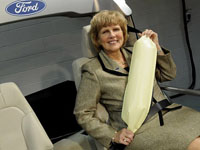Ford Represents Inflatable Seat Belts
After about a decade of engineering, Ford is ready to offer a technology that will improve safety for rear-seat passengers: inflatable seat belts.

The belts expand like an air bag in the event of a crash and distribute the force of the impact across a wider area of the passenger's chest. The belts, covered in a softer webbing than regular seat-belt material, may also make back-seat passengers more willing to buckle up.
"It feels a lot different; it's softer and more lightly woven," says Sue Cischke, group vice president of sustainability, environmental and safety engineering. "When we asked people to sample them, they said it feels less rigid and more comfortable."
Consistent seat-belt use is lower for rear-seat than front-seat passengers. The National Highway Traffic Safety Administration says 83% of front-seat passengers buckled up consistently in 2008, vs. 74% of rear-seat passengers.
The belts first will be an option on the next-generation Ford Explorer in the U.S., then rolled out in Europe and other markets.
They were first shown as a concept at the 2001 North American International Auto Show in Detroit, and Ford has been grinding away at them since. The project even survived the financial distress in 2005, when Ford shed thousands of employees in an attempt to stem losses.
Then-CEO Bill Ford emphasized, however, that work on innovative technology should continue. At that point, the inflatable seat belt was five years into development, and it made the cut.
Srini Sundararajan, technical leader for Ford's research and advanced engineering division confesses there was a lot of doubt about the project. "People kept saying, 'It cannot be done, inflatable belts cannot be done,' while all the tests we kept doing kept saying, 'It can be done, it can be done.' "
Among the technical hurdles: the rear belts' air bags had to be much gentler than front air bags, which inflate with enough force to break out through the instrument panel, then release hot gas as they deflate. The belts will inflate with less force and use cool gas, Sundararajan says, making them safer for passengers of all sizes.
"We ensured that it was harmless," he says. "One of the extreme conditions we tested was a sleeping child situation, where the child puts his head on the seat belt and sleeps. We tested that, and it works great. We didn't see any cause for concern."
The team tested the belts when used with car seats, booster seats with high backs and booster seats with low backs. If the seat belt is not buckled, the system won't go off.
Sundararajan says he's pleased the technology is finally making its way into cars, and hopes it will become a widespread safety feature.
USA Today has contributed to the report.
Subscribe to Pravda.Ru Telegram channel, Facebook, RSS!


